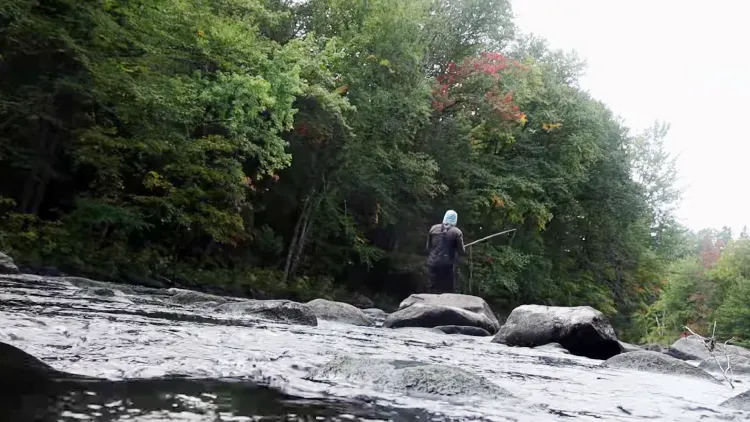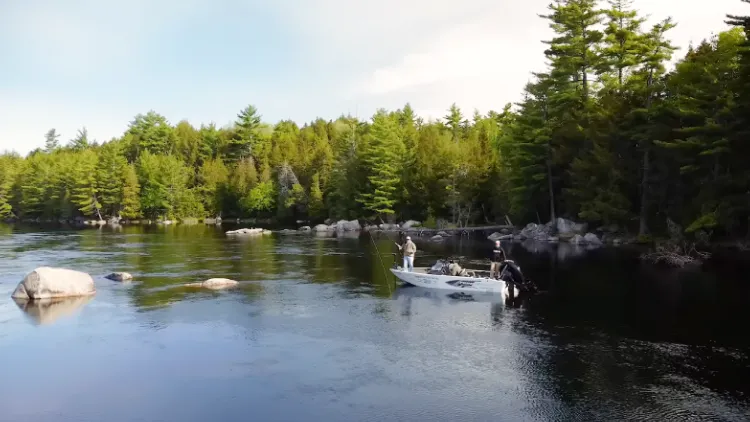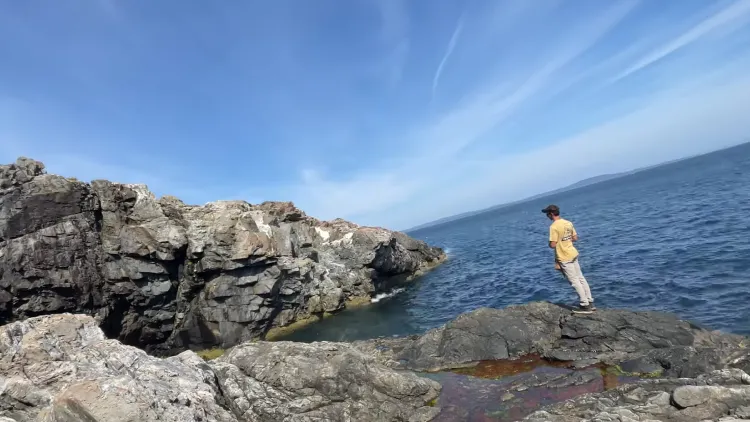Key Takeaways:
- Maine offers diverse fly fishing opportunities for brook trout, landlocked salmon, and other species across scenic locations like the Kennebec River, Rangeley Lakes, and the Rapid River.
- Timing your visit is extremely important. Spring for ice-out conditions, summer for active fish, fall for salmon runs, and winter for ice fishing.
- The state’s abundant fish species include brook trout, landlocked salmon, brown and rainbow trout, smallmouth bass, Atlantic salmon, and striped bass.
- For fly fishing in Maine, a valid angling license is a must, and specific regulations on bait, seasons, bag limits, and minimum lengths apply to different species.
- Maine’s pristine wilderness and urban access near cities like Portland make it a perfect destination for fly fishing, offering anglers a great catch, breathtaking scenery, and outdoor activities.
List of the 9 Best Places to Fly Fishing in Maine

Maine offers many exceptional fly fishing locations, each with its unique charm. Here are some of the most popular fly fishing spots in the state, along with their specialties and other noteworthy aspects:
- Kennebec River
- Rangeley Lakes
- Rapid River
- Moosehead Lake
- West Branch of the Penobscot River
- Androscoggin River
- Sebago Lake
- Magalloway River
- Roach River
1. Kennebec River
- The Kennebec River winds along 170 miles in Maine, including Moosehead Lake and The Forks.
- With its renowned landlocked salmon and brook trout, as well as opportunities to catch smallmouth bass, striped bass, and Atlantic salmon. This river is particularly well-suited for drift boats and wade fishing.
- As you take in the breathtaking scenery of the Kennebec River flowing through the state’s wilderness, you can also enjoy the fresh air and tranquility of the great outdoors.
2. Rangeley Lakes
- The Rangeley Lakes can be accessed from the town of Rangeley in western Maine, in Franklin County.
- These deep, pristine lakes are home to large brook trout and landlocked salmon, providing excellent fly and streamer fishing opportunities.
- As you fish in the Rangeley Lakes, you can enjoy the stunning views of the picturesque western Maine mountains, adding to the allure of the already impressive fishing experience.
3. Rapid River
- The Rapid River flows 6.0 miles from Lower Richardson Lake to Umbagog Lake in the northwestern portion of Maine.
- Brook trout are king on the Rapid River, which is catch-and-release only, so the fish population stays healthy. Fly fishers can expect to catch fish ranging from 12 to 18 inches in length.
- Situated in a remote wilderness area, the Rapid River provides a tranquil fishing experience, not to mention the chance to catch spectacular brook trout.
4. Moosehead Lake
- Located in Piscataquis County in Northwestern Maine, Moosehead Lake is the largest lake in the state.
- Moosehead Lake is a deep, coldwater lake and home to brook trout, salmon, and landlocked salmon, which offer excellent fly fishing opportunities.
- This lake is the biggest in Maine, providing various outdoor activities for anglers and families, making it an ideal destination for a fishing vacation.
5. West Branch Penobscot River
- Considered a tributary of the Penobscot River, the West Branch Penobscot River is a 117-mile-long river flowing through the North Maine Woods.
- Penobscot River’s West Branch is renowned for its landlocked salmon and wild brook trout, making it a great spot to try river and pond fly fishing.
- The picturesque surroundings and proximity to Baxter State Park offer additional activities like hiking and camping. You can also enjoy the beauty of the forest as you fish.
6. Androscoggin River
- If you’re looking for a hub of variety, the Androscoggin River has you covered. This river flows south from Umbagog Lake to Gorham, NH, and east to Jay, Maine.
- The Androscoggin River offers excellent fly fishing opportunities for different fish species, including trout, smallmouth bass, and salmon, with various sections catering to different fishing preferences.
- Accessibility and the opportunity to float on the river for a diverse fishing experience. The beautiful river location will also add to your fishing adventure, making it an unforgettable memory.
7. Sebago Lake
- Sebago Lake is located in the southern region of Maine. It’s 316 feet deep at its deepest point and 101 feet at its mean depth.
- This Lake is famous for its landlocked salmon and lake trout fishing opportunities. You can access the Songo/Crooked via Park Access Road, where you’ll find abundant fish species to cast your line for.
- Sebago Lake is located within a short distance of Portland, Maine’s largest city, meaning you’ll have the perfect balance of outdoor and urban activities. Whether you want to fish during the day and take in the city’s sights by night, Sebago Lake has it all.
8. Magalloway River
- Magalloway River is situated in northern Maine, a remote and picturesque location. The west branch of the Magalloway River offers a 48-mile stretch of fishable water that makes for an invigorating fly fishing experience.
- This River is home to a glorious mixture of brook trout and landlocked salmon fishing. The river is ideal for a fly fisher looking for solitude and peace in the great outdoors.
- Beautiful mountains surround the Magalloway River, perfect for the avid nature enthusiast. The river’s remoteness makes it ideal for those seeking a peaceful location for fly fishing without traveling too far.
9. Roach River
- The Roach River flows through Spencer Bay in Kokadjo and Moosehead Lake.
- Fishing is only permitted on this 6.5-mile-long freshwater river in northern Maine, making it perfect for those looking for a challenge. The waterway teems with brook trout, which average around 15 inches long.
- Mount Kineo and the scenic views that come with it are right next to the Roach River. The setting of the Roach River is serene and remote, offering fly fishers the perfect escape.
Maine fly fishing season: when is the best time to fish?
The cooler temperatures and fewer bugs make for an ideal fishing environment during the fall months. Not only that, but the stunning foliage in Maine creates a breathtaking backdrop to your fishing adventures, making it a must-visit time of year.
While spring is also a great time for fly fishing, with hatches occurring in late spring and early summer, the fall offers a wider variety of species to target, including salmon runs in rivers like the Penobscot and Kennebec.
Summer can also provide excellent fly fishing opportunities, especially during the early morning and late evening when the water is cooler and the fish are more active. However, the warmer weather can make wading and float trips uncomfortable.
Winter fly fishing is less common in Maine due to cold temperatures, but ice fishing on frozen lakes and ponds for adventurous anglers can yield catches of lake trout, brook trout, and salmon.
What fish species can be caught with fly fishing in Maine?

If you’re looking for native species, brook trout is the way to go. These beautiful fish are often found in cold, clear mountain streams and remote ponds. They’re notoriously elusive, making the challenge of catching them with fly gear all the more rewarding.
But if you’re more interested in larger fish species, landlocked salmon is an excellent choice. These fish are found in many of Maine’s larger lakes and can grow up to 30 inches long. Sebago Lake, Moosehead Lake, and West Grand Lake are all well-known spots for fly fishing for landlocked salmon.
Do you enjoy the thrill of the hunt? Then brown trout might be the species for you. These fish can be found in some of Maine’s rivers and streams, including the Kennebec River, the Androscoggin River, and the Presumpscot River.
Rainbow trout is another species that can be caught in various rivers and streams throughout Maine. Kennebec River, Penobscot River, and the Magalloway River are good spots to target rainbow trout with fly gear. This species prefers cooler water temperatures and can grow up to 24 inches long.
While not traditionally associated with fly fishing, smallmouth bass can still be targeted using fly gear in Maine’s warmer waters. Belgrade Lakes, Sebago Lake, or the Saco River are good locations for smallmouth bass.
Finally, for saltwater fly fishing enthusiasts, striped bass can be targeted in coastal areas such as Casco Bay, the Kennebec River estuary, and the Saco River estuary. These fish can grow up to 48 inches long and are known for their fight and powerful runs.
What are Maine’s fly fishing rules?
- A valid fishing license is required for fishing in inland waters.
- Use or possession of live fish as bait is prohibited; however, other legal forms of bait, artificial lures, and artificial flies are permitted.
- Fishing seasons vary depending on the zone and range from April 1 to September 30 (open-water fishing) to closed seasons from October 1 to March 31.
- There are specific daily bag and possession limits and minimum length limits for various species in lakes/ponds and rivers/streams/brooks.
- Species with specific regulations include brook trout, brown trout, rainbow trout, landlocked salmon, togue (lake trout), bass (largemouth and smallmouth), whitefish, and smelts.
- Some species, like sea-run Atlantic salmon, are federally endangered, and no fishing is permitted.
#Note: These regulations may change at any time. Visit the official Maine Department of Inland Fisheries and Wildlife website for the latest rules & regulations and any additional local rules that may apply.

